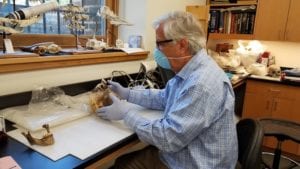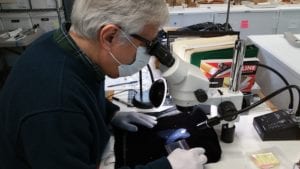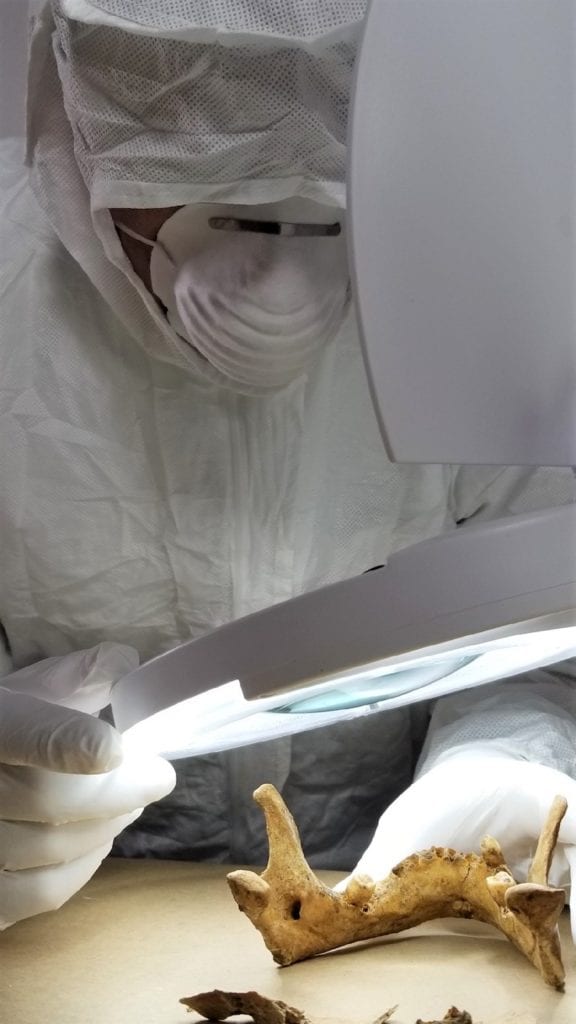A Different Kind of Case
AAE member Dr. Martin D. Levin applies his endodontic expertise to archaeology and murder mysteries

After DNA analysis was performed by others, Dr. Levin images the maxilla of H. H. Holmes with an intraoral laser scanner. The resulting 3D surface scan and later cone beam computed tomography scan proved his identity when compared to photographs of his prison dental models.
Compiled by Michael Dobrow
You go to a general dentist for routine oral health care and an endodontist for root canal treatment, but did you know that these professionals can also provide historical information about the long departed?
Enter endodontist Dr. Martin D. Levin, a highly skilled, Board-certified AAE member. Dr. Levin has taken his training a step further to explore historical information that his knowledge can uncover. His analysis of dental remains has provided information about America’s early settlers and helped solve mysteries about America’s first serial killer.
The American Association of Endodontists (AAE) recently interviewed Dr. Levin about his work with archaeologists and nanoscale scientists, and much more! Below is a Q&A between Dr. Levin and AAE Integrated Communications Specialist Michael Dobrow.
Dobrow: Thank you for taking the time to speak with me, Dr. Levin. Before we really dive in, can you tell me a bit about your background?
Dr. Levin: I earned my degree in dental medicine and completed my post-doctoral residency in endodontics at the University of Pennsylvania in 1974. I have been involved in clinical care, research and teaching since starting my career in endodontics. I live in the Washington, DC area.
Dobrow: The work you perform isn’t just isolated to patients who sit in your dental chair and the endodontic specially about which you have written and lectured as a professor. For example, you’ve also worked with historians and archeologists to study the remains of America’s first settlers at Jamestown in the early 17th century. Can you tell me about how you got involved in archeology and relate some of your experiences?
Dr. Levin: My interest began in 2013 while viewing an exhibit at the Smithsonian’s National Museum of Natural History. In 2004, archeologists at Jamestown discovered the skeletal remains of a teenage boy believed to have been killed during a skirmish between the early settlers and the Powhatan Indians in May of 1607, only two weeks after arriving from England. Examination of the boy by archeologists revealed a large periapical abscess in his mandible that apparently resulted from a fractured tooth. I thought that further investigation might tell us more about his life, so I called Dr. Douglas Owsley, Curator of Biological Anthropology at the Smithsonian’s National Museum of Natural History. He agreed and transported the boy’s skull to my office and allowed me to perform an evaluation.
The examination, aided by CBCT, digital radiography and my operating microscope, revealed that a traumatic injury to the tooth occurred when the boy was approximately eight years old. This resulted in a pulp exposure, arrested root development and an area eventually filled with impacted food and debris. The root canal was a perfect layered reservoir just waiting to be examined.

Dr. Levin conducts a microscopic examination of an incisor recovered from a triple burial that occurred on August 14, 1607, at Jamestown. After transport to a clean room at Virginia Commonwealth University’s Nanomaterials Core Characterization Facility, the intact pulp was extirpated by Dr. Levin for possible DNA analysis.
With the permission of the Smithsonian, Jamestown Rediscovery’s Director of Collections Michael Lavin and Director of Archaeology David Givens, we moved the project to the Virginia Commonwealth University’s Nanomaterials Core Characterization Facility. There, along with researcher Dr. Joshua Cohen, I was able to excavate the contents of the root canal in a clean room and examine the tooth and a portion of the root canal contents with nanoscale instruments. Using a sophisticated scanning electron microscope, electron-dispersive x-rays, focus-stacking microscopy, confocal Raman spectroscopy and ultra-high-resolution micro-CT equipment, we were able to begin to analyze the contents of his root canal and what the boy was eating.
Then, we traveled to a Denver-based paleobotanist to further characterize the food and debris in the canal.
Dobrow: This all came about out of your own curiosity?
Dr. Levin: Exactly. As a result of this investigation, I began to talk to audiences about my interest in archeology to explain the value of curiosity. Just pursuing my curiosity ended up taking me on a personal adventure that has expanded my horizons and introduced me to many expert scientists in a number of disciplines.
Dobrow: That’s incredible! And, what did your examination discover about the young boy?
Dr. Levin: By studying this boy’s skull and teeth, we were able to more closely determine the boy’s age, his likely diet and more about life in the early 17th century. In the root canal, just below the crown fracture, the small sample examined showed three kinds of pine pollen consistent with his short stay at Jamestown, biogenic silica from food and cereal grains and signature starches from England.
According to John Smith’s diary, the Powhatan Indians’ attack occurred while the boy was planting corn. Did the boy eat some of the corn he was planting? In the root canal specimen, we found starch consistent with the presence local zia mays (corn) – indicating that he was eating some of the kernels that he was in the process of planting. We also found multiple strands of cotton that he possibly used to prevent food impaction. Since medicated poultices were known in the Middle Ages, further investigations are ongoing to determine if the cotton in his tooth was medicated.
Dobrow: This all came from studying a tiny portion of a 400-plus-year-old root canal in a tooth that was in the soil along with his remains?
Dr. Levin: Yes, I was amazed to see how much we could learn from an incredibly small specimen, only a twelfth of the root canal contents of his mandibular left lateral incisor. With the use of some of the tools that endodontists use in daily practice, along with advanced nanoscale instruments, our team was able learn more about this boy’s diet and the story of his short life. I am incredibly honored to participate in these investigations.
Dobrow: We can really learn a lot from someone’s natural teeth, even with such a small specimen.
In one of our exchanges, you mentioned that you joined a team of archeologists at the University of Pennsylvania to help settle the mysteries around whether Chicago’s World’s Fair serial killer H.H. Holmes, the subject of the novel, The Devil in the White City by Erik Larson, was in fact buried in a nearby Philadelphia cemetery. How did you get involved in that one? Can you tell me more about this experience?
University of Pennsylvania anthropologists Drs. Janet Monge and Samantha Cox were engaged by the History Channel to determine if H. H. Holmes was actually the person executed at Moyamensing Prison in Philadelphia in 1896 for the murders he committed. The Delaware County Court approved a request by Holmes’ descendants to have his grave exhumed, but the condition of his body was not amenable to definitive DNA analysis. Since I was already conducting other research with Professor Monge, I was asked to document and compare Holmes’ teeth with photographs of his dental casts in his prison records. We performed a CBCT and laser scan of his mandible and maxilla to segment his teeth and create a virtual model of his dentition, which exactly matched his prison dental records. After the tests were concluded, Holmes’ body was reinterred.
I think it is important to note that these and other forensic studies I’ve been involved with have included contributions by many dedicated experts in multiple disciplines.
Dobrow: What do you plan to do next?

In the lab at Jamestown Rediscovery, Dr. Levin examines the mandible of a specimen presumed to be Sir George Yeardley, Lord Governor of Jamestown. An isolation suit was worn to minimize DNA contamination of the specimen. (Photo by Michael Lavin, Jamestown Rediscovery).
Dr. Levin: These investigations are ongoing and require the adoption of new technologies along with expert
collaboration at Penn, the National Institutes of Standards and Technology and other labs. Our current assessment of the remains believed to be Sir George Yeardley, Lord Governor of Jamestown, is using advanced imaging technologies such as scanning electron microscopy, micro-CT and laser-generated digital modeling to learn more about his dental condition, foodways and what role his medical status may have played in his last years. While we know that he wrote his last will and testament about a month before he died in 1627, at the age of approximately 39, we don’t know what led to his death. Did other early settlers suffer a similar fate? All of this remains to be determined.
Michael Dobrow is an integrated communications specialist with the AAE. He can be reached at mdobrow@aae.org.




